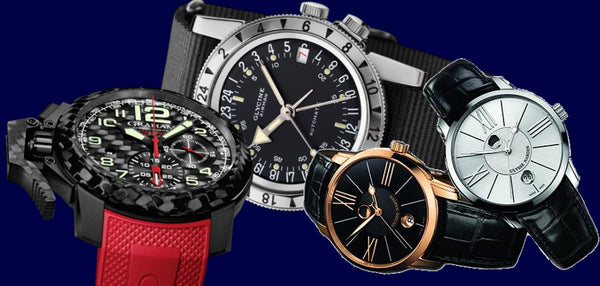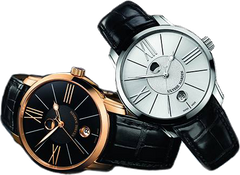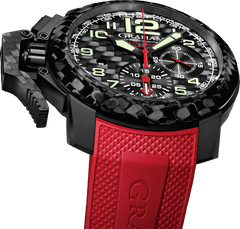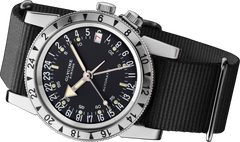How to Buy a Watch Part 1: Watch Style

Here at TimeScapeUSA, we love the clients for whom a fine timepiece constitutes an impulse item. It's raining out, so in a fit of pique you purchase a dive watch rated to a thousand meters. A sad song on the radio reminds you of your First Girl, and while you can never have her back, that dial on that rose gold dress piece is the same color as her eyes. As for the rest of us, we realize that a watch can be a daunting purchase. Before you deploy the hard-earned lucre more rightly stashed in the kid's college fund, allow us to advise you on the proper process for acquiring that one of a kind piece.
Today in Part 1 I'll describe some of the major districts in the country of contemporary watch design, while in Part 2 I'll usher you through the process of judging the merits of any particular timepiece. While one's own taste must be the final arbiter, greater knowledge is hardly a disadvantage.Here at TimeScapeUSA, we love the clients for whom a fine timepiece constitutes an impulse item. It's raining out, so in a fit of pique you purchase a dive watch rated to a thousand meters. A sad song on the radio reminds you of your First Girl, and while you can never have her back, that dial on that rose gold dress piece is the same color as her eyes. As for the rest of us, we realize that a watch can be a daunting purchase. Before you deploy the hard-earned lucre more rightly stashed in the kid's college fund, allow us to advise you on the proper process for acquiring that one of a kind piece.
Today in Part 1 I'll describe some of the major districts in the country of contemporary watch design, while in Part 2 I'll usher you through the process of judging the merits of any particular timepiece. While one's own taste must be the final arbiter, greater knowledge is hardly a disadvantage.
Dress Watch
Wrist watches began as jewelry for women, and it was only after the advent of the trench watch during the Great War that men began to affect them. The 20's and 30's are the well that the industry continues to visit for clues to elegance and real style. The hallmark of the dress piece is understated elegance, and a slim design that can rest below the cuff. The dress pieces of today are larger than yesterday, and while this reflects contemporary tastes it is also a necessity required by more durable, water resistant modern cases. But don't expect a dress piece to shout that it is made of gold, or to see a lug that could only be the product of convolute CAD machinations.
men began to affect them. The 20's and 30's are the well that the industry continues to visit for clues to elegance and real style. The hallmark of the dress piece is understated elegance, and a slim design that can rest below the cuff. The dress pieces of today are larger than yesterday, and while this reflects contemporary tastes it is also a necessity required by more durable, water resistant modern cases. But don't expect a dress piece to shout that it is made of gold, or to see a lug that could only be the product of convolute CAD machinations.
Dress pieces tend to be dominated by dials of simple, fresh design, with more restrained indications of time and date. It is rare to see a profusion of functions or external controls breaking the line of the case. In the TimeScapeUSA collection, Ulysse Nardin and Glycine both present models that would have been at home on your grandfather's wrist. Grand Seiko raises the dress watch aesthetic to the level of design ethic: the best, quietly.
Professional Watch
The first best use of the traveling timepiece was in the guise of the navigational deck chronometer. Companies like Ulysse Nardin created pieces that made the calculation of longitude relatively simple, opening the way to trans-oceanic navigation. At TimeScapeUSA we don't recommend a 10 pound brass gimbal for your wrist, but there are other ways to evoke the rigors of a mission-critical environment.
Pilot watches wer e some of the first pieces to marry aesthetics to critical functions like chronographs and circular slide rules for calculating fuel consumption. Contemporary versions of these important pieces have large, open faces with a high contrast color scheme – usually broad white hands and markers against a mat-black dial. These were the first watches to make extensive use of luminous paint and 24 hour dials for night-time flying. For especially long flights, indication of a second time zone was also possible. In our collection, several Glycine pieces draw on this storied tradition of function and style, and most Graham watches bear the distinctive trigger mechanism for operating the chronograph with heavy flight gloves.
e some of the first pieces to marry aesthetics to critical functions like chronographs and circular slide rules for calculating fuel consumption. Contemporary versions of these important pieces have large, open faces with a high contrast color scheme – usually broad white hands and markers against a mat-black dial. These were the first watches to make extensive use of luminous paint and 24 hour dials for night-time flying. For especially long flights, indication of a second time zone was also possible. In our collection, several Glycine pieces draw on this storied tradition of function and style, and most Graham watches bear the distinctive trigger mechanism for operating the chronograph with heavy flight gloves.
Dive watches continue to be a favorite well outside the narrow confines of profession. With their over-built cases and high-contrast dials, their distinctive features have come to dominate our idea of contemporary watch design. The indexed ratcheting bezel, heavy rubber strap, and even the expanding deployant clasp engineered for the wetsuit sleeve – these we all owe to the dive watch. While early models were purpose-built (and priced) for professionals only, brands like Ulysse Nardin, Graham, and of course Seiko continue the tradition through homage designs with genuine functionality.
Sport Watch
And here we progress to the modern idea of the sport watch. The engineering behind dive watches – robust cases with serious gasketing – combined with shock protected mechanical movements or quartz technology allows for pieces  reflecting our new ideas of leisure. While our gentleman forebears would never dreamed of exercising for pleasure, now men and women both wear watches styled for work and play. The aggressive, engaging features of the modern sport watch – thick ornamental cases with exotic combinations of rubber, metal, and ceramic in designs emphasizing bold planes and angles – are as at home in the board room as they are on the trail. If you're looking for a timepiece that compels the eye, look no further than Graham, Glycine, Ulysse Nardin, or Seiko.
reflecting our new ideas of leisure. While our gentleman forebears would never dreamed of exercising for pleasure, now men and women both wear watches styled for work and play. The aggressive, engaging features of the modern sport watch – thick ornamental cases with exotic combinations of rubber, metal, and ceramic in designs emphasizing bold planes and angles – are as at home in the board room as they are on the trail. If you're looking for a timepiece that compels the eye, look no further than Graham, Glycine, Ulysse Nardin, or Seiko.
The sport watches of today incorporate the full range of technical functions – calendars, chronographs, as well as internal indications of the state of the watch like its power reserve or sapphire windows into the mechanism itself. In an era of technological mastery, the modern sport watches celebrates the horological accomplishments of the past by stacking them one on another and demanding our attention.
In Part 2 we'll explore ways to put some of this information to use when we look under the hood, so to speak, of some of these fabulous pieces and decide which one might be the right watch for you.
